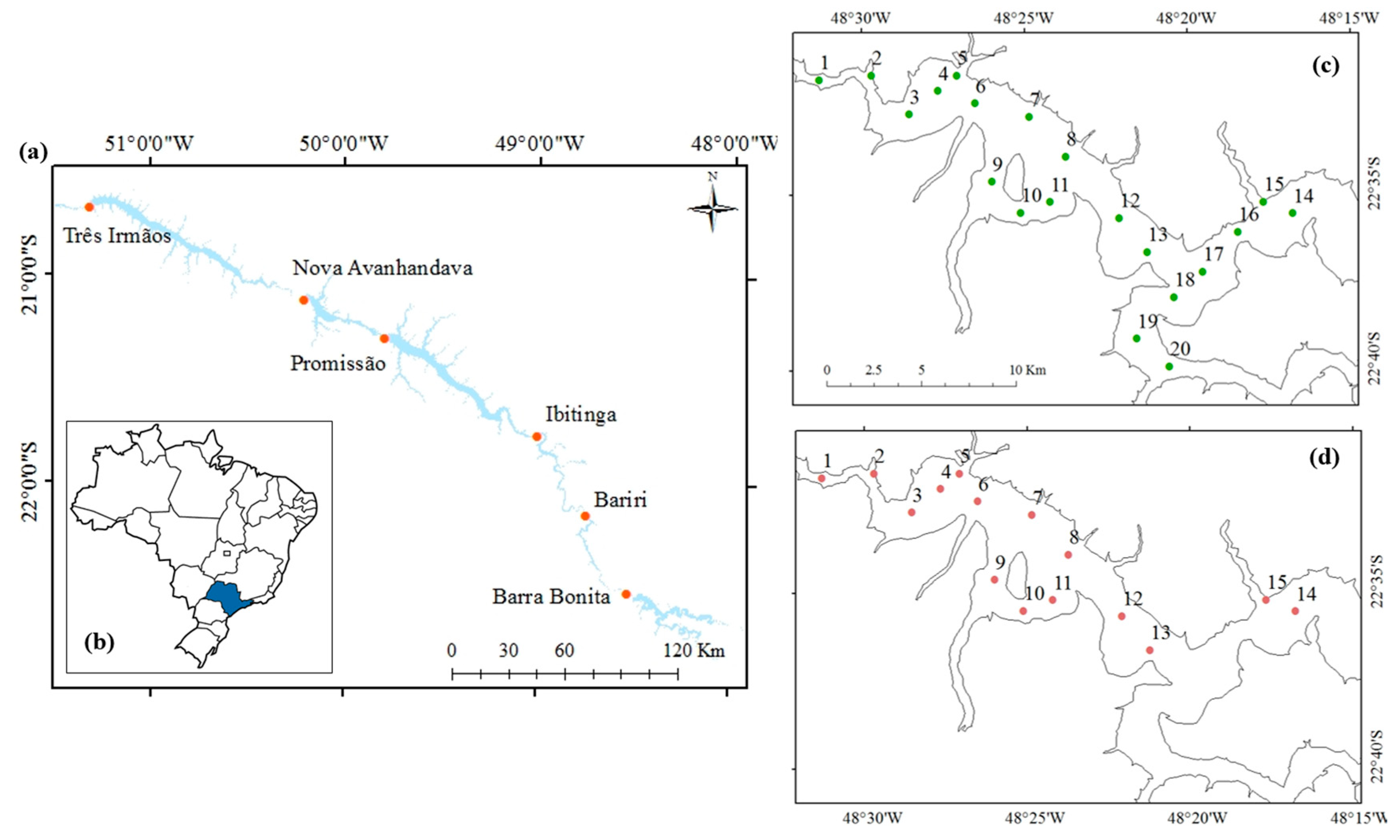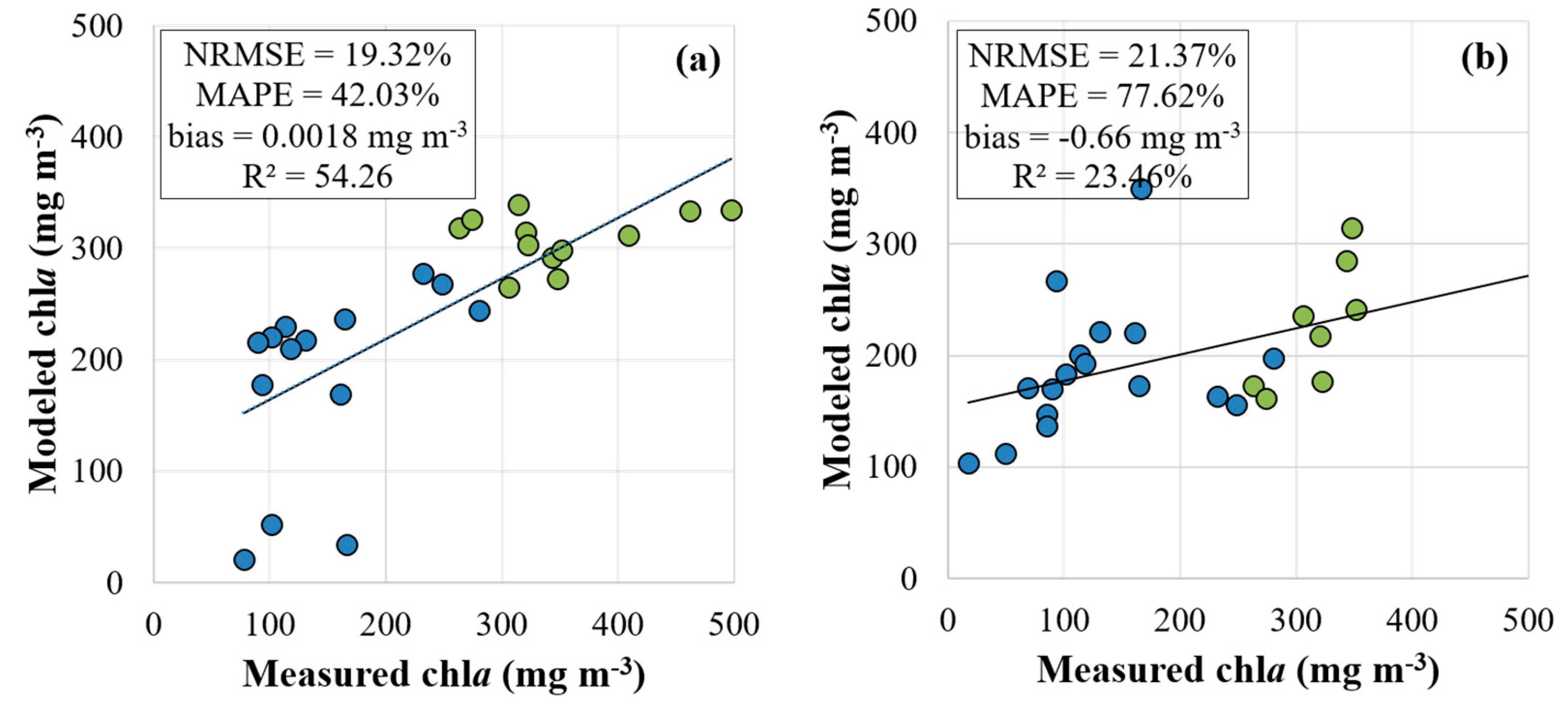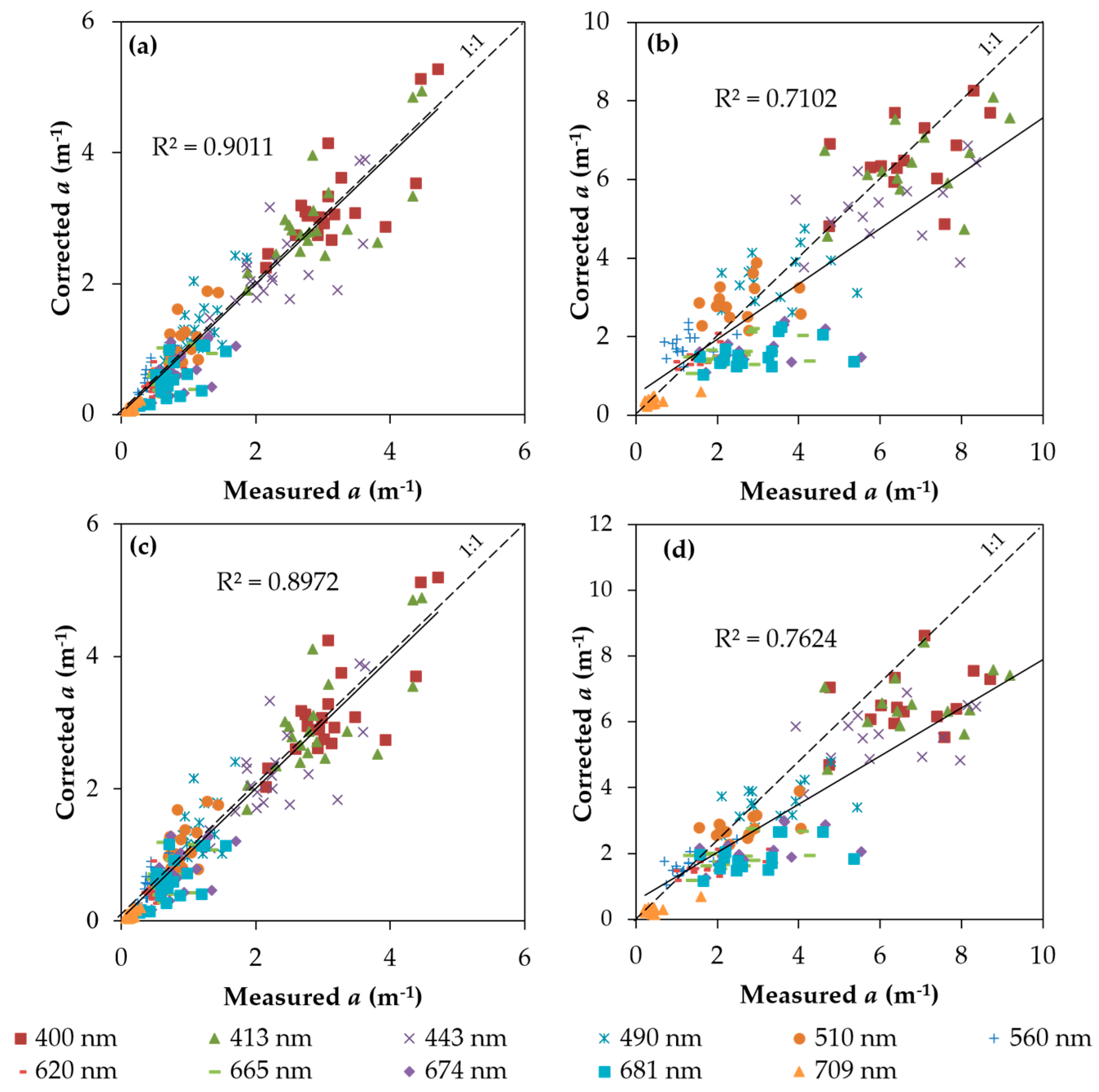Assessment of Scattering Error Correction Techniques for AC-S Meter in a Tropical Eutrophic Reservoir
Abstract
:1. Introduction
2. Materials and Methods
2.1. Study Area
2.2. Data Collection
2.3. Correction of ac-s Data
2.3.1. Temperature and Salinity Correction
2.3.2. Scattering Error Correction
2.4. Absorption Measured in the Laboratory
2.5. Chla and TSM Concentrations
2.6. Evaluation of the Correction Techniques
2.7. Calibration and Validation of the Chla Prediction Algorithm
3. Results
3.1. Scattering Error Correction
3.2. Implication in Modeling Chla Content
4. Discussion
5. Conclusions
Author Contributions
Acknowledgments
Conflicts of Interest
References
- Mobley, C.D. Light and Water: Radiative Transfer in Natural Waters; Academic Press: San Diego, CA, USA, 1994. [Google Scholar]
- Smith, R.C.; Baker, K.S. The bio-optical state of ocean waters and remote sensing. Limnol. Oceanogr. 1978, 23, 247–259. [Google Scholar] [CrossRef]
- Stramski, D.A.; Bricaud, A.; Morel, A. Modeling the inherent optical properties of the ocean based on the detailed composition of the planktonic community. Appl. Opt. 2001, 40, 2929–2945. [Google Scholar] [CrossRef] [PubMed]
- Babin, M.D.; Stramski, G.M.; Ferrari, G.M.; Claustre, H.; Bricaud, A.; Obolensky, G.; Hoepffner, N. Variations in the light absorption coefficients of phytoplankton, nonalgal particles, and dissolved organic matter in coastal waters around Europe. J. Geophys. Res. 2003, 108, 3211. [Google Scholar] [CrossRef]
- Bricaud, A.H.; Claustre, H.; Ras, J.; Oubelkheir, K. Natural variability of phytoplankton absorption in oceanic waters: Influence of the size structure of algal populations. J. Geophys. Res. 2004, 109, C11011. [Google Scholar] [CrossRef]
- Loos, E.A.; Costa, M. Inherent optical properties and optical mass classification of the waters of the Strait of Georgia, British Columbia, Canada. Prog. Oceanogr. 2010, 87, 144–156. [Google Scholar] [CrossRef]
- Campbell, G.; Phinn, S.R.; Daniel, P. The specific inherent optical properties of three sub-tropical and tropical water reservoirs in Queensland, Australia. Hydrobiologia 2011, 658, 233–252. [Google Scholar] [CrossRef]
- Wu, G.; Cui, L.; Duan, H.; Fei, T.; Liu, Y. Absorption and backscattering coefficients and their relations to water constituents of Poyang lake, China. Appl. Opt. 2011, 50, 6358–6368. [Google Scholar] [CrossRef] [PubMed]
- Ferreira, A.; Garcia, C.A.E.; Dogliotti, A.I.; Garcia, V.M.T. Bio-optical characteristics of the Patagonia Shelf break waters: Implications for ocean color algorithms. Remote Sens. Environ. 2013, 136, 416–432. [Google Scholar] [CrossRef]
- Riddick, C.A.L.; Hunter, P.D.; Tyler, A.N.; Martinez-Vicente, V.; Horváth, H.; Kovács, A.W.; Vörös, L.; Preston, T.; Présing, M. Spatial variability of absorption coefficients over a biogeochemical gradient in a large and optically complex shallow lake. J. Geophys. Res. Ocean. 2015, 120, 7040–7066. [Google Scholar] [CrossRef] [Green Version]
- Alcântara, E.; Watanabe, F.; Rodrigues, T.; Bernardo, N.; Rotta, L.; Carmo, A.; Curtarelli, M.; Imai, N. Field measurements of the backscattering coefficients in a cascading reservoir system: First results from Nova Avanhandava and Barra Bonita reservoirs (São Paulo, Brazil). Remote Sens. Lett. 2016, 7, 417–426. [Google Scholar] [CrossRef]
- Roesler, C.S.; Perry, M.J.; Carder, K.L. Modeling in situ phytoplankton absorption from total absorption spectra in productive inland marine waters. Limnol. Oceanogr. 1989, 34, 1510–1523. [Google Scholar] [CrossRef]
- Babin, M.; Therriault, J.C.; Legendre, L.; Condal, A. Variations in the specific absorption coefficient for natural phytoplankton assemblages: Impact on estimates of primary production. Limnol. Oceanogr. 1993, 38, 154–177. [Google Scholar] [CrossRef]
- Bricaud, A.; Babin, M.; Morel, A.; Claustre, H. Variability in the chlorophyll-specific absorption coefficients of natural phytoplankton: Analysis and parameterization. J. Geophys. Res. 1995, 100, 13321–13332. [Google Scholar] [CrossRef]
- Garcia, C.A.E.; Garcia, V.M.T.; Dogliotti, A.I.; Ferreira, A.; Romero, S.I.; Mannino, A.; Souza, M.S.; Matta, M.M. Environmental conditions and bio-optical signature of a cocolithophorid bloom in the Patagonian shelf. J. Geophys. Res. 2011, 116, C03025. [Google Scholar] [CrossRef]
- Lee, Z.P.; Carder, K.L.; Mobley, C.D.; Steward, R.G.; Patch, J.S. Hyperspectral remote sensing for shallow waters. I. A semianalytical model. Appl. Opt. 1998, 37, 6329–6338. [Google Scholar] [CrossRef] [PubMed]
- Gordon, H.R.; Brown, O.; Evans, R.H.; Brown, J.W.; Smith, R.C.; Baker, K.S.; Clark, D.K. A semianalytical radiance model of ocean color. J. Geophys. Res. 1988, 93, 10909–10924. [Google Scholar] [CrossRef]
- Canizzaro, J.P.; Carder, K.L. Estimating chlorophyll a concentration from remote-sensing reflectance in optically shallow waters. Remote Sens. Environ. 2006, 101, 13–24. [Google Scholar] [CrossRef]
- Tzortziou, M.; Subramaniam, A.; Herman, J.R.; Gallegos, C.L.; Neale, P.J.; Harding, L.W., Jr. Remote sensing reflectance and inherent optical properties in the mid Chesapeake bay. Estuar. Coast. Shelf 2007, 72, 16–32. [Google Scholar] [CrossRef]
- Carder, K.L.; Chen, F.R.; Lee, Z.P.; Hawes, S.K. Semianalytical Moderate-Resolution Imaging Spectrometer algorithm for chlorophyll a and absorption with bio-optical domains based on nitrate-depletion temperatures. J. Geophys. Res. 1999, 104, 5403–5421. [Google Scholar] [CrossRef]
- Brando, V.E.; Dekker, A.G. Satellite hyperspectral remote sensing for estimating estuarine and coastal water quality. IEEE Trans. Geosc. Remote Sens. 2003, 41, 1378–1387. [Google Scholar] [CrossRef]
- Gitelson, A.A.; Dall’Olmo, G.; Moses, W.; Rundquist, D.C.; Barrow, T.; Fisher, T.R.; Gurlin, D.; Holz, J. A simple semi-analytical model for remote estimation of chlorophyll-a in turbid waters: Validation. Remote Sens. Environ. 2008, 112, 3582–3593. [Google Scholar] [CrossRef]
- Mobley, C.D.; Sundman, L.K. Hydrolight 5.2, Ecolight 5.2: User’s Guide; Sequoia Scientific: Bellevue, WA, USA, 2013. [Google Scholar]
- Martinez-Vicente, V.; Land, P.E.; Tilstone, G.H.; Widdicombe, C.; Fishwich, J.R. Particulate scattering and backscattering related to water constituents and seasonal changes in the Western English channel. J. Plankton Res. 2010, 32, 603–619. [Google Scholar] [CrossRef]
- Carvalho, L.A.S.; Barbosa, C.C.F.; Novo, E.M.L.M.; Rudorff, C.M. Implications of scatter corrections for absorption measurements on optical closure of Amazon floodplain lakes using spectral absorption and attenuation meter (ac-s—WETLabs). Remote Sens. Environ. 2015, 157, 123–137. [Google Scholar] [CrossRef]
- Hout, Y.; Morel, A.; Twardowski, M.S.; Stramski, D.; Reynolds, A. Particle optical backscattering along a chlorophyll gradient in the upper layer of the eastern South Pacific ocean. Biogeosciences 2008, 5, 495–507. [Google Scholar] [CrossRef]
- Antoine, A.; Siegel, A.; Kostadinov, T.; Maritorena, S.; Nelson, N.B.; Gentili, B.; Vellucci, V.; Guilocheau, N. Variability optical particle backscattering in contrasting bio-optical oceanic regimes. Limnol. Oceanogr. 2011, 56, 955–973. [Google Scholar] [CrossRef]
- Zaneveld, J.R.; Kitchen, J.C.; Moore, C. The scattering error correction of reflecting-tube absorption meters. Proc. SPIE 1994, 2258, 44–55. [Google Scholar] [CrossRef]
- Kirk, J.T.O. Monte Carlo modeling of the performance of a reflective tube absorption meter. Appl. Opt. 1992, 31, 6463–6469. [Google Scholar] [CrossRef] [PubMed]
- Mckee, D.; Piskozub, J.; Brown, I. Scattering error corrections for in situ absorption and attenuation measurements. Opt. Express 2008, 16, 19480–19492. [Google Scholar] [CrossRef] [PubMed]
- Stockley, N.D.; Röttgers, R.; Mckee, D.; Fefering, I.; Sullivan, J.M.; Twardowski, M.S. Assessing uncertainties in scattering correction algorithms for reflective tube absorption measurements made with a WET Labs ac-9. Opt. Express 2017, 25, A1139. [Google Scholar] [CrossRef] [PubMed]
- Leymarie, E.; Doxaran, D.; Babin, M. Uncertainties associated to measurements of inherent optical properties in nature waters. Appl. Opt. 2010, 49, 5415–5436. [Google Scholar] [CrossRef] [PubMed]
- Röttgers, R.; Mckee, D.; Woźniak, B. Evaluation of scatter corrections for ac-9 absorption measurements in coastal waters. Methods Oceanogr. 2013, 7, 21–39. [Google Scholar] [CrossRef]
- Roesler, C.S. Theoretical and experimental approaches to improve the accuracy of particulate absorption coefficients derived from the quantitative filter technique. Limnol. Oceanogr. 1998, 43, 1649–1660. [Google Scholar] [CrossRef]
- Abe, D.S.; Matsumura-Tundisi, T.; Rocha, O.; Tundisi, G. Denitrification and bacterial community structure in the cascade of six reservoirs on a tropical river in Brazil. Hydrobiologia 2003, 504, 67–76. [Google Scholar] [CrossRef]
- Matsumura-Tundisi, T.; Tundisi, J.G. Plankton richness in a eutrophic reservoir (Barra Bonita reservoir, SP, Brazil). Hydrobiologia 2005, 542, 367–378. [Google Scholar] [CrossRef]
- Calijuri, M.C.; dos Santos, A.C.A. Short-term changes in the Barra Bonita reservoir (São Paulo, Brazil) emphasis on the phytoplankton communities. Hydrobiologia 1996, 330, 163–175. [Google Scholar] [CrossRef]
- Watanabe, F.S.Y.; Alcântara, E.H.; Rodrigues, T.W.P.; Bernardo, N.M.R.; Rotta, L.H.S.; Imai, N.N. Phytoplankton community dynamic detection from the chlorophyll-specific absorption coefficient in productive inland waters. Acta Limnol. Bras. 2017, 29, e13. [Google Scholar] [CrossRef]
- Dellamano-Oliveira, M.J.; Vieira, A.A.H.; Rocha, O.; Colombo, V.; Sant’Anna, C.L. Phytoplankton taxonomic composition and temporal changes in a tropical reservoir. Fundam. Appl. Limnol. 2008, 17, 27–38. [Google Scholar] [CrossRef]
- Tundisi, J.G.; Matsumura-Tundisi, T.; Pereira, K.C.; Luzia, A.P.; Passerini, M.D.; Chiba, W.A.C.; Morais, M.A.; Sebastian, N.Y. Cold fronts and reservoir limnology: An intergrated approach towards the ecological dynamics of freshwater ecosystems. Braz. J. Biol. 2010, 70, 815–824. [Google Scholar] [CrossRef] [PubMed]
- Barbosa, F.A.R.; Padisák, J.; Espíndola, E.L.; Borics, G.; Rocha, O. The cascading reservoirs continuum concept (CRCC) and its application to the rover Tietê-basin, São Paulo State, Brazil. In Theoretical Reservoir Ecology and Its Application; Tundisi, J.G., Straškraba, M., Eds.; International Institute of Ecology: São Carlos, Brazil, 1999; pp. 425–437. [Google Scholar]
- Pegau, W.S.; Zaneveld, R.V. Temperature-dependent absorption of water in the red and near-infrared portions of the spectrum. Limnol. Oceanogr. 1993, 38, 188–192. [Google Scholar] [CrossRef]
- Sullivan, J.M.; Twardowski, M.S.; Zaneveld, R.V.; Moore, C.M.; Bernard, A.H.; Donaghay, P.L.; Rhoades, B. Hyperspectral temperature and salt dependencies of absorption by water and heavy water in the 400–750 nm spectral range. Appl. Opt. 2006, 45, 5294–5309. [Google Scholar] [CrossRef] [PubMed]
- Imai, N.N.; Shimabukuro, M.H.; Carmo, A.F.C.; Alcântara, E.H.; Rodrigues, T.; Watanabe, F. Bio-optical data integration based on a 4 D database system approach. Int. Arch. Photogramm. Remote Sens. Spat. Inf. Sci. 2015, XL-7/W3, 635–641. [Google Scholar] [CrossRef]
- Tassan, S.; Ferrari, G.M. An alternative approach to absorption measurements of aquatic particles retained on filters. Limnol. Oceanogr. 1995, 40, 1358–1368. [Google Scholar] [CrossRef]
- Tassan, S.; Ferrari, G.M. Measurements of light absorption by aquatic particles retained on filters: Determination of the optical path length amplification by the ‘transmittance-reflectance’ method. J. Plankton Res. 1998, 20, 1699–1709. [Google Scholar] [CrossRef]
- Tassan, S.; Ferrari, G.M. A sensitivity analysis of the ‘transmittance-reflectance’ method for measuring light absorption by aquatic particles. J. Plankton Res. 2002, 24, 757–774. [Google Scholar] [CrossRef]
- Cleveland, J.S.; Weidemann, A.D. Quantifying absorption by aquatic particles: A multiple scattering correction for glass-fiber filters. Limnol. Oceanogr. 1993, 38, 1321–1327. [Google Scholar] [CrossRef]
- Bricaud, A.; Morel, A.; Prieur, L. Absorption by dissolved organic matter of the sea (yellow substance) in the UV and visible domains. Limnol. Oceanogr. 1981, 26, 43–53. [Google Scholar] [CrossRef]
- Golterman, H.L.; Clymo, R.S.; Ohnstad, M.A.M. Methods for Physical and Chemical Analysis of Fresh Water; Blackwell Scientific Publications: Oxford, UK, 1978. [Google Scholar]
- American Public Health Association (APHA); American Water Works Association (AWWA); Water Environmental Federation (WEF). Standard Methods for the Examination of Water and Wastewater, 20th ed.; APHA; AWWA; WEF: Washington, DC, USA, 1998; pp. 2–54. [Google Scholar]
- Kruse, F.A.; Lefkoff, A.B.; Boardman, J.W.; Heidebrecht, K.B.; Shapiro, A.T.; Barloon, P.J.; Goetz, A.F.H. The spectral image processing system (SIPS)—interactive visualization and analysis of imaging spectrometer data. Remote Sens. Environ. 1993, 44, 145–163. [Google Scholar] [CrossRef]
- Lee, Z.P.; Carder, K.L. Absorption spectrum of phytoplankton pigments derived from hyperspectral remote-sensing reflectance. Remote Sens. Environ. 2004, 89, 361–368. [Google Scholar] [CrossRef]
- Watanabe, F.; Alcântara, A.; Imai, N.; Rodrigues, T.; Bernardo, N. Estimation of chlorophyll-a concentration from optimizing a semi-analytical algorithm in productive inland waters. Remote Sens. 2018, 10, 227. [Google Scholar] [CrossRef]
- Donlon, C.; Berruti, B.; Buongiorno, A.; Ferreira, M.H.; Féménias, P.; Frerick, J.; Goryl, P.; Klein, U.; Laur, H.; Mavrocordatos, C.; et al. The global monitoring for environment and security (GMES) Sentinel-3 mission. Remote Sens. Environ. 2012, 120, 37–57. [Google Scholar] [CrossRef]





| Parameter | Min | Max | Mean | SD | CV |
|---|---|---|---|---|---|
| Dataset collected on 5–9 May 2014, n = 20 samples | |||||
| Chla | 17.7 | 279.9 | 120.4 | 70.3 | 58.4 |
| TSM | 3.6 | 16.3 | 7.2 | 3.3 | 45.8 |
| ISM | 0.2 | 4.4 | 1.1 | 0.9 | 78.8 |
| OSM | 2.8 | 14.7 | 6.1 | 3.2 | 52.0 |
| SDD | 0.8 | 2.3 | 1.5 | 0.4 | 26.7 |
| Turbidity | 1.7 | 12.5 | 5.2 | 2.4 | 46.2 |
| Dataset collected on 13–16 October 2014, n = 15 samples | |||||
| Chla | 263.2 | 797.8 | 415.4 | 159.2 | 38.3 |
| TSM | 10.8 | 44.0 | 23.5 | 7.4 | 31.7 |
| ISM | 0.6 | 3.8 | 2.5 | 1.0 | 40.9 |
| OSM | 10.2 | 30.4 | 19.5 | 4.8 | 24.6 |
| SDD | 0.37 | 0.78 | 0.56 | 0.11 | 19.1 |
| Turbidity | 15.1 | 33.2 | 19.8 | 5.2 | 26.3 |
| Method | RMSE | NRMSE | MAPE | bias | SAM |
|---|---|---|---|---|---|
| Correction for May 2014 | |||||
| Flat | 0.257 | 7.95 | 29.26 | 0.048 | 0.103 |
| Constant fraction | 0.292 | 9.25 | 49.20 | 1.127 | 0.199 |
| Proportional | 0.263 | 8.22 | 30.57 | 0.053 | 0.098 |
| Correction for October 2014 | |||||
| Flat | 0.969 | 13.03 | 34.89 | −0.182 | 0.154 |
| Constant fraction | 3.124 | 48.14 | 859.84 | 3.046 | 0.348 |
| Proportional | 0.833 | 11.20 | 31.03 | −0.131 | 0.127 |
© 2018 by the authors. Licensee MDPI, Basel, Switzerland. This article is an open access article distributed under the terms and conditions of the Creative Commons Attribution (CC BY) license (http://creativecommons.org/licenses/by/4.0/).
Share and Cite
Watanabe, F.; Rodrigues, T.; Do Carmo, A.; Alcântara, E.; Shimabukuro, M.; Imai, N.; Bernardo, N.; Rotta, L.H. Assessment of Scattering Error Correction Techniques for AC-S Meter in a Tropical Eutrophic Reservoir. Remote Sens. 2018, 10, 740. https://doi.org/10.3390/rs10050740
Watanabe F, Rodrigues T, Do Carmo A, Alcântara E, Shimabukuro M, Imai N, Bernardo N, Rotta LH. Assessment of Scattering Error Correction Techniques for AC-S Meter in a Tropical Eutrophic Reservoir. Remote Sensing. 2018; 10(5):740. https://doi.org/10.3390/rs10050740
Chicago/Turabian StyleWatanabe, Fernanda, Thanan Rodrigues, Alisson Do Carmo, Enner Alcântara, Milton Shimabukuro, Nilton Imai, Nariane Bernardo, and Luiz Henrique Rotta. 2018. "Assessment of Scattering Error Correction Techniques for AC-S Meter in a Tropical Eutrophic Reservoir" Remote Sensing 10, no. 5: 740. https://doi.org/10.3390/rs10050740
APA StyleWatanabe, F., Rodrigues, T., Do Carmo, A., Alcântara, E., Shimabukuro, M., Imai, N., Bernardo, N., & Rotta, L. H. (2018). Assessment of Scattering Error Correction Techniques for AC-S Meter in a Tropical Eutrophic Reservoir. Remote Sensing, 10(5), 740. https://doi.org/10.3390/rs10050740







